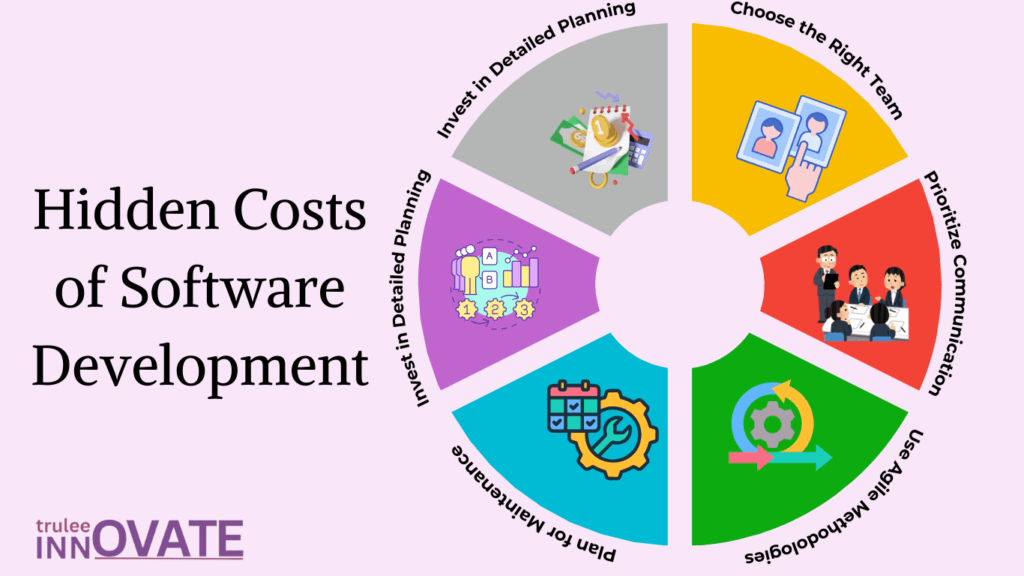Introduction: Why Software Development Costs More Than You Think
Software development has become a cornerstone for businesses aiming to thrive in the digital age. From custom applications to complex enterprise systems, software enables businesses to streamline operations, improve customer experiences, and drive revenue growth. However, one aspect of software development that often catches businesses off guard is the hidden costs of software development. While the initial quote or project estimate may appear reasonable, unforeseen expenses can quickly inflate the total cost, leaving businesses grappling with budget overruns.
In this blog, we will delve deep into these hidden costs, shedding light on where they originate and how businesses can plan for them. By understanding these hidden expenses, companies can approach software development projects with realistic expectations and strategies to mitigate financial surprises.
The Importance of Budget Planning in Software Development
Effective budget planning is the foundation of a successful software development project. Unfortunately, many businesses fail to account for all potential expenses when creating a budget, focusing solely on development costs. This oversight often leads to underfunded projects, delays, and even project failures.
A well-planned budget should encompass more than just coding costs. It should include costs related to research, design, testing, deployment, maintenance, and unforeseen contingencies. Businesses should also account for indirect costs such as communication, project management, and training. Without a comprehensive budget, the hidden costs of software development can spiral out of control, jeopardizing the entire project.
Unveiling the Hidden Costs of Software Development: An Overview
Hidden costs in software development can manifest at every stage of the project lifecycle. These costs often stem from:
- Miscommunication and unclear requirements.
- Changes in project scope.
- Technical debt.
- Testing and quality assurance.
- Post-launch maintenance and updates.
- Delays and missed deadlines.
Each of these factors contributes to the overall expense of the project, often in ways that are not immediately apparent during the planning phase. Let’s explore these hidden costs in detail.
Hidden Costs in the Planning Phase
The planning phase sets the stage for the entire project, but it’s also where many hidden costs originate. Common issues include:
1. Misaligned Requirements
When project requirements are not clearly defined, developers may build features that do not align with business goals. This can lead to wasted time and resources, as well as the need for costly rework.
2. Insufficient Research
Failing to conduct thorough market research or feasibility studies can result in unrealistic expectations and poor decision-making. For instance, choosing the wrong technology stack can lead to compatibility issues and additional expenses down the line.
3. Stakeholder Communication
Coordinating with multiple stakeholders to finalize requirements can be time-consuming and expensive. Miscommunication or delays in approvals can stall the project and increase costs.
Development Phase Pitfalls: Unseen Expenses
Testing and Quality Assurance: The Underestimated Expenses
Testing and quality assurance (QA) are critical to ensuring the software functions as intended, but they come with their own set of hidden costs. These include:
1. Bug Fixes
Bugs discovered late in the development process can be expensive to fix, particularly if they require significant changes to the codebase.
2. Testing Tools
Comprehensive testing often requires specialized tools and platforms, which can be costly. For example, performance testing tools or automated testing frameworks may require additional licensing fees.
3. Extended Testing Timelines
Inadequate testing can lead to software failures post-launch, necessitating additional testing cycles and further delaying the project.
Maintenance and Post-Launch Costs
Many businesses underestimate the ongoing costs associated with maintaining and updating software after its initial launch. These costs include:
1. Bug Fixes and Updates
Even the most meticulously developed software is likely to encounter bugs or require updates to stay compatible with evolving technologies.
2. Scalability
As user demand grows, the software may need to be scaled to handle increased traffic or data. This often involves additional infrastructure investments and optimization efforts.
3. Security Enhancements
Cybersecurity threats are ever-evolving, necessitating regular updates to protect sensitive data and maintain user trust.
The Cost of Delayed Timelines
Delays are one of the most common sources of hidden costs in software development. They can result from a variety of factors, including:
1. Unforeseen Challenges
Technical challenges, such as integrating third-party APIs or resolving compatibility issues, can extend project timelines and increase costs.
2. Opportunity Costs
Delays can prevent businesses from capitalizing on market opportunities, leading to lost revenue and competitive disadvantages.
Hidden Costs in Outsourcing and Vendor Management
Outsourcing software development to third-party vendors can be a cost-effective strategy, but it also comes with hidden expenses:
1. Communication Barriers
Working with offshore teams can lead to miscommunication due to time zone differences, language barriers, or cultural differences.
2. Vendor Lock-In
Relying on a single vendor for critical aspects of development can limit flexibility and lead to higher costs if the vendor increases their rates or fails to meet expectations.
The Role of Hidden Costs in Custom vs. Off-the-Shelf
Both custom and off-the-shelf software solutions have hidden costs that businesses must consider:
Custom Software
- Higher initial development costs.
- Longer development timelines.
- Ongoing maintenance and scalability expenses.
Off-the-Shelf Software
- Licensing and subscription fees.
- Limited customization options, leading to potential inefficiencies.
- Integration challenges with existing systems.
How to Mitigate the Hidden Costs of Software Development
While it’s impossible to eliminate all hidden costs, businesses can take proactive steps to minimize them:
- Invest in Detailed Planning: Clearly define project requirements and objectives from the outset.
- Choose the Right Team: Work with experienced developers who understand your industry.
- Prioritize Communication: Maintain open and transparent communication with all stakeholders.
- Conduct Regular Testing: Identify and address issues early to avoid costly fixes later.
- Plan for Maintenance: Include post-launch support and updates in your budget.
- Use Agile Methodologies: Agile development allows for flexibility and iterative improvements, reducing the risk of costly rework.

Conclusion: Planning for the Unseen
Although they are an unavoidable aspect of software development, hidden expenses don’t have to cause your project to fail. You can guarantee a more successful conclusion and a more seamless development process by being aware of these expenses and factoring them into your strategy and budget. To successfully navigate the challenges of software development, proactive budgeting and risk management are essential, regardless of whether you’re developing custom software or using an off-the-shelf solution.


